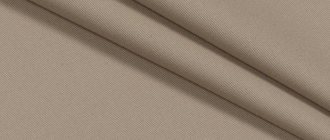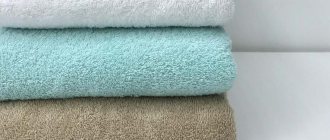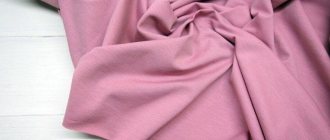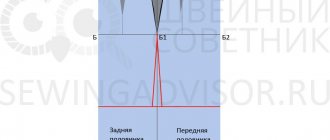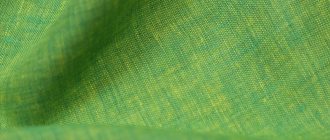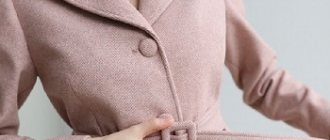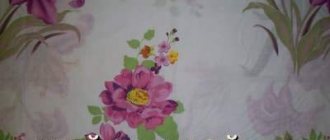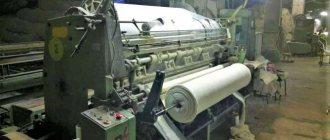What kind of light fabric is this?
Light fabric is a dependent type of fabric. This is the name given to materials that are less dense than the main type. For example, antistatic light fabric, Barbie light. Dress fabrics, technical fabrics, and furniture fabrics are also “lightweight”.
To understand what kind of fabric light is, you need to consider what material it is made from. General description of light fabric is a thin, light fabric of low density. The texture and properties may differ slightly from the base material. Thus, light teak is produced using a plain weave rather than a twill weave; its surface is smooth and non-relief. And the lightweight Barbie fabric, due to the cotton in its composition, wrinkles more than the classic version.
Reviews about light fabrics are mostly positive. Consumers note the high quality and hygiene of dress materials marked light. Clothes made from them are comfortable in the heat. The canvases are not inferior in strength and wear resistance to the main type.
Light fabric: variations
To know what light fabric looks like, you need to pay attention to the basic version.
The first example would be tick light. Teak is a natural material based on flax or cotton fibers. Its basic characteristic is increased density – up to 160 g/m2. In the lightweight version, this indicator is not higher than 140 g/m2.
For the production of the standard type, the satin or twill weave method is used, while the lightweight type is produced using plain weave. Lightweight teak is suitable for creating curtains, curtains, bed linen, and work clothes. Among the main characteristics are the following:
Easy air permeability;
Ability to absorb moisture;
Environmental safety;
Long service life.
The second type will be satori light fabric.
The satori blend is half cotton and half polyester. The fabric is necessary for sewing work clothes, which imposes density requirements - for the standard version up to 145 g/m2. However, in the hot season, such clothes are not comfortable, so a lightweight version with a density of 115 g/m2 is offered. This variety remains as interesting in quality as the main type:
Compound
The composition of light fabric can be either natural or mixed or synthetic. When it comes to dress fabrics, cotton, viscose or their combinations are most often used. A small amount of polyester or elastane fibers can be added to them (no more than 5-10%).
Technical “lightweight” textiles are predominantly synthetic. There are also mixed options in which cotton is added to polyester. But its percentage is less than 35-40%.
Upholstery materials of the light group are usually made from synthetic fibers. This provides them with strength and increased wear resistance.
Products made from such fabric
Elegant knitted, extremely fashionable and beautiful fabric. High quality products are made from it for any season and taste. Things made from this material are soft to the touch and warm.
Punto occupies one of the first places in the textile industry. The fabric has a matte surface, which attracts the attention of the consumer, and can be painted in any color. An interesting effect is achieved by the dense weave of very thick fibers. Punta fabric is widely used when sewing women's and children's blouses, men's jumpers, sweatshirts, and cardigans. Does this material stretch or not? Many people ask themselves this question. The fabric stretches well, does not restrict movement, and has sufficient elasticity. Even after wearing the products for a long time, the material does not stretch and looks excellent. Products made from punta fabric perfectly combine practicality and durability, simplicity, beauty and elegance. Caring for knitwear is simple - wash in warm water, do not bleach, iron with a warm iron or do not iron at all.
Types and their properties
The characteristics of light fabrics are very diverse, depending on the lightweight version of which fabric they are. They produce knitted, stretch, and fire-resistant light fabrics.
“Lightweight” materials are conventionally divided into four groups. Dresses from which clothes are sewn. Furniture ones are suitable for upholstering sofas and armchairs. Technical workers are used to sew workwear and uniforms. The fourth group of fabrics is for sewing bed linen.
Let's look at a few representatives from the first group:
- barbie light . It is made from cotton with the addition of elastane. It holds its shape well, things do not deform when worn. It has good hygienic properties;
- Pandora light fabric . Suit material is crepe weave. It stretches well over both the warp and the weft and drapes well. It contains 95% polyester and 5% elastane;
- knitwear Roma light . This is a knitted blend fabric. It consists of viscose (60%), nylon (35%), elastane (5%). The textile is soft to the touch and stretches well. Clothes made from it do not deform when worn;
- light taffeta fabric . Thin synthetic fabric made of polyester and nylon. It is smooth and delicate, flowing. Linings for outerwear are sewn from it. After special water-repellent treatment, it is used to make advertising banners or awnings.
Light technical textiles are used for sewing workwear and outdoor advertising:
What is Milano?
It should be noted right away that two different materials are offered on the fabric market under similar names. Sometimes this name goes by high-quality furniture velor, which is also commonly called “Milan” or “Milan”. As for Milano, this fabric is a knitwear, and may include:
- wool;
- cotton;
- silk;
- viscose;
- polyester;
- elastane;
- spandex.
As a rule, Milano has a mixed fiber composition. The peculiarity of these knitted fabrics is their rather thick threads and very tight weave, thanks to which they hold their shape very well and do not crumble when cutting . The canvases have a beautiful matte surface, they are made both plain and printed. Depending on the thickness, nature of the raw materials and external design, this fabric has many varieties. The most common varieties of Milano are:
- jersey, classic thick knitwear, often with a predominance of wool fibers;
- Academician, which contains predominantly viscose;
- punto is the most common mixed material with a predominance of polyester;
- Roma is a rather thin fabric with the addition of cotton.
Related article: Knitting a beautiful warm skirt for women: pattern with description
Application area
Light group materials are widely used. They are used for sewing clothes: dresses, blouses, trousers. These are mainly summer models.
Light fabrics are suitable for sewing wedding and evening dresses. Flowing, well-draped materials are used for them.
For light evening dresses, fabrics are combined with lace or leather. The Genevieve dress model looks impressive with a belt made of Dior light jersey with an openwork insert.
They make suits from fabrics (satori) for workers in food production and housing and communal services. Surgical gowns are made from light materials, for example, the classic gown in blue.
Sofas, armchairs, chairs, poufs are upholstered with light fabrics. Some varieties, for example, satin, are used to make curtains for offices or government agencies.
Application and properties
It can be argued that this knitwear is universal in the manufacture of practical and beautiful clothes for both adults and children. A huge variety of structures, composition and colors makes Milano suitable for any wardrobe item, and its high density allows you to form finishing details in the form of volumetric folds, various gathers, flounces, etc. These same properties contribute to the widespread use of this material in interior design: for screens, curtains, bedspreads, furniture covers and other types of home textiles.
The main properties of such products are:
- high density;
- stretchability, especially when adding spandex;
- resistance to deformation, including under constant loads;
- the ability to hold its shape well and fit the figure beautifully;
- the ability to create volumetric and relief structural elements;
- variety of colors and prints;
- softness and comfort;
- beauty and elegance;
- ability for air exchange even in the densest fabrics;
- ability to retain heat well;
- durability;
- crease resistance.
Thin silk and viscose jersey with spandex is ideal for beautiful and comfortable underwear.
Cotton fibers, viscose and the thin thickness of Roma fabric make it very suitable for summer dresses, blouses, T-shirts, tops, and the addition of elastane contributes to a good fit of products made from it.
Milano punto material has a very beautiful matte surface, great softness and elasticity and is considered the most elegant variety of this material; it is widely used for casual and elegant women's dresses and suits, blouses, knee socks, leggings, as well as for elegant children's clothing. Depending on the thickness and composition, punto products can be suitable for any season.
Academic and jersey are suitable for thick closed dresses, cardigans, suits, trousers and jackets, and thick woolen knitwear is used for warm and comfortable outerwear.
It should be remembered that Milano is very durable and can look “like new” for a long time, so when creating clothes from it, designers give preference to simple and elegant models that will not lose their relevance over the years.
Care
Caring for products made from light materials will depend on the composition; carefully read the tag on the clothing. In general, dress materials can be washed at 30°C by hand or on a delicate cycle in a washing machine. If necessary, iron clothes from the wrong side with a non-hot iron.
Dear readers of the Tkan.Club website, if you still have questions on this topic, we will be happy to answer them. Leave your reviews, comments, share stories if you have dealt with this material! Your life experience may be useful to other readers.
How to care?
Caring for mixed fabrics is easy, and the high elasticity of Milano and its ability to withstand mechanical stress ensure that these knitted products will retain their attractiveness even after a large number of washes. Of course, before washing, you should carefully study the description of the fabric and the manufacturer's instructions included.
Related article: Epoxy resin for jewelry: an easy master class with photos and videos
Synthetic fibers, which are necessarily included in these materials, are recommended to be washed in warm water and using high-quality detergents without bleaches, and the durable structure of the fabric allows the use of machine spinning and drying. This fabric is practically indestructible, but it tolerates ironing well at temperatures not exceeding 110 degrees.
What is light fabric?
The composition of light fabric has similar features to the main one, with the exception of some features.
| Property | Description |
| Density | Less main fabric. |
| Weight | Less than the original material. |
| Thickness | Thin fabric is designed for sewing summer clothes. |
| Elasticity | It is observed in those carriers whose characteristics initially implied the ability to stretch. |
For information! Despite the combination of thinness and elasticity, light products hold their shape well.
Produced using plain weave (approx. Most models are made using the twill method). Visually it stands out due to its smooth surface with no relief.
